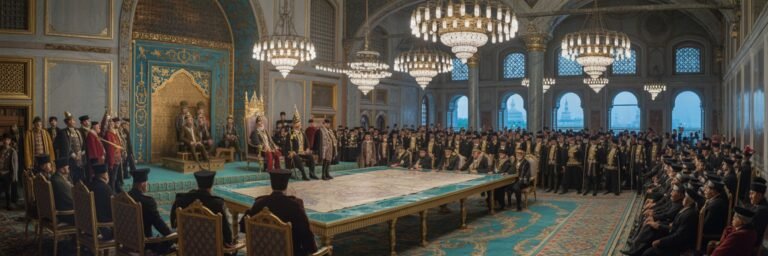INTRODUCTION
One of the most profound and enduring legacies bequeathed to the world has been from the Ottoman Empire. This powerful state, occupying a frenzy of regional domains at its zenith, stamped an indelible mark on the sands of history across its vast theaters of influence in Europe, Asia, and Africa. Sprawling over six centuries, the Ottoman Empire brought about a vibrant fusion of cultures, ideologies, and paradigms. It weaved together tales of military might, political prowess, artistic marvel, and religious fortitude.
HISTORICAL BACKGROUND
From the quintessential cavalry officer Osman I, whose overthrow of the Byzantine city of Bilecik in 1299 AD marked the genesis of this empire, till Mehmed VI, who abdicated amidst the political turmoil of the early 20th century, the legacy of the Ottoman Empire was colored by the acts of 36 sultans. They commandeered the empire through a tumultuous voyage of discovery, conquest, and consolidation, reaching the apogee of power in the 16th and 17th centuries under illustrious figures such as Suleiman the Magnificent.
Wielding the double-edged sword of military and religious authority, the Ottomans unified their territories geo-politically and philosophically. They combined Turkic, Greek, Armenian, Arab, and various Balkan traditions, integrating them into a distinctive Turkish-Islamic synthesis. This blend became tangible in various shared facets of Ottoman society – in government, law, art, and literature.
THEORIES AND INTERPRETATIONS
Numerous theories abound concerning the rise, endurance, and fall of the Ottoman Empire, which stretched across 600 years – a lifetime far beyond most comparable all-conquering empires. According to Halil İnalcık, one of Turkey’s preeminent historians, the empire’s longevity could be attributed to what he termed as ‘the circle of justice’. Essentially, it was a social contract – a mutual pact of support and maintenance – between the ruling class and the ruled. The sultans promised protection, justice, and prosperity to the commoners, who, in turn, vowed their loyalty.
However, not all scholarly conjectures were as glowing. British historian Edward Freeman, for instance, saw the empire as a ‘terrible despotism’. Other observers alluded to the so-called ‘Sick Man of Europe’ – a gradual decline brought about by economic troubles, military failures, and the inability to adapt to the changing world order at the turn of the 19th century.
MYSTERIES AND CONTROVERSIES
Various mysteries shroud the Ottoman Empire’s narrative, adding to its enigma and allure. For instance, the controversial fratricide law, known as the ‘Law of Governance’. This law, supposedly decreed by Mehmed the Conqueror, ordained that upon a sultan’s death, his sons would fight for the throne, with the victor executing his brothers to eliminate competition. The veracity of this brutal law, however, remains debated.
Another source of controversy was the empire’s treatment of minorities, the most notorious being the Armenian, Assyrian, and Pontic Greek genocides around World War I. These events have led to intense debates over the exact extent and intentionality of these calamities, stirring contemporary geopolitics.
SYMBOLISM AND CULTURAL SIGNIFICANCE
The Ottoman Empire left an indelible print on global culture. The minarets of Istanbul conversed with the realms of Byzantine architecture to form the immortal Echo of Blue, conjoining Christian and Islamic symbolism in a tableau of captivating beauty. The tulips that the Dutch covet were originally Ottoman wildflowers, becoming an iconic symbol of the empire during the ‘Tulip Era’ from 1718 to 1730.
The empire pioneered spiritual syncretism, incorporating multifarious cultural and religious motifs. Its polyglot bureaucracy and the practice of devshirme, that recruited and trained Christian boys for elite service, accentuated the empire’s cosmopolitan construct.
MODERN INVESTIGATIONS
Contemporary research has illuminated different aspects of the Ottoman Empire’s labyrinthine chronicle. The genocides’ contentious history has been rigorously documented and disseminated, despite facing suppression in Turkey itself. The work of Taner Akçam on the Armenian genocide remains pivotal.
State-of-the-art archaeological and architectural surveys, combined with GIS technology, have granted spectacular insights into bygone Ottoman cities, revealing advanced urban planning and intricate architectural prowess. Similarly, new interpretations of digitized Ottoman archives have unveiled nuanced perspectives on the empire’s governance and societal fabric.
LEGACY AND CONCLUSION
The empire’s end did not signal an end to its influence, as the framework of modern Turkey was forged from the Ottoman crucible. Many middle eastern legal systems and institutions still bear the imprint of Ottoman governance. Moreover, the potent imagery of the Ottoman past is weaponized in the contemporary political rhetoric of Turkey.
Undoubtedly, the Ottoman Empire’s legacy transcends the binary of good or bad. It is a vivid canvas painted with the hues of military achievements, intellectual endeavors, societal changes, and regressive policies. This rich mosaic should not invalidate or glorify an event, person, or epoch but must serve to broaden our understanding of human ambition, capability, folly, and incongruity.
Beautiful and barbaric, benevolent and brutal, inspirational yet intimidating, the Ottoman Empire’s cultural legacy is a profound chapter, a testament to the transformative power of unified diversity — an enduring parable of the intertwined triumphs and trials of humanity.






